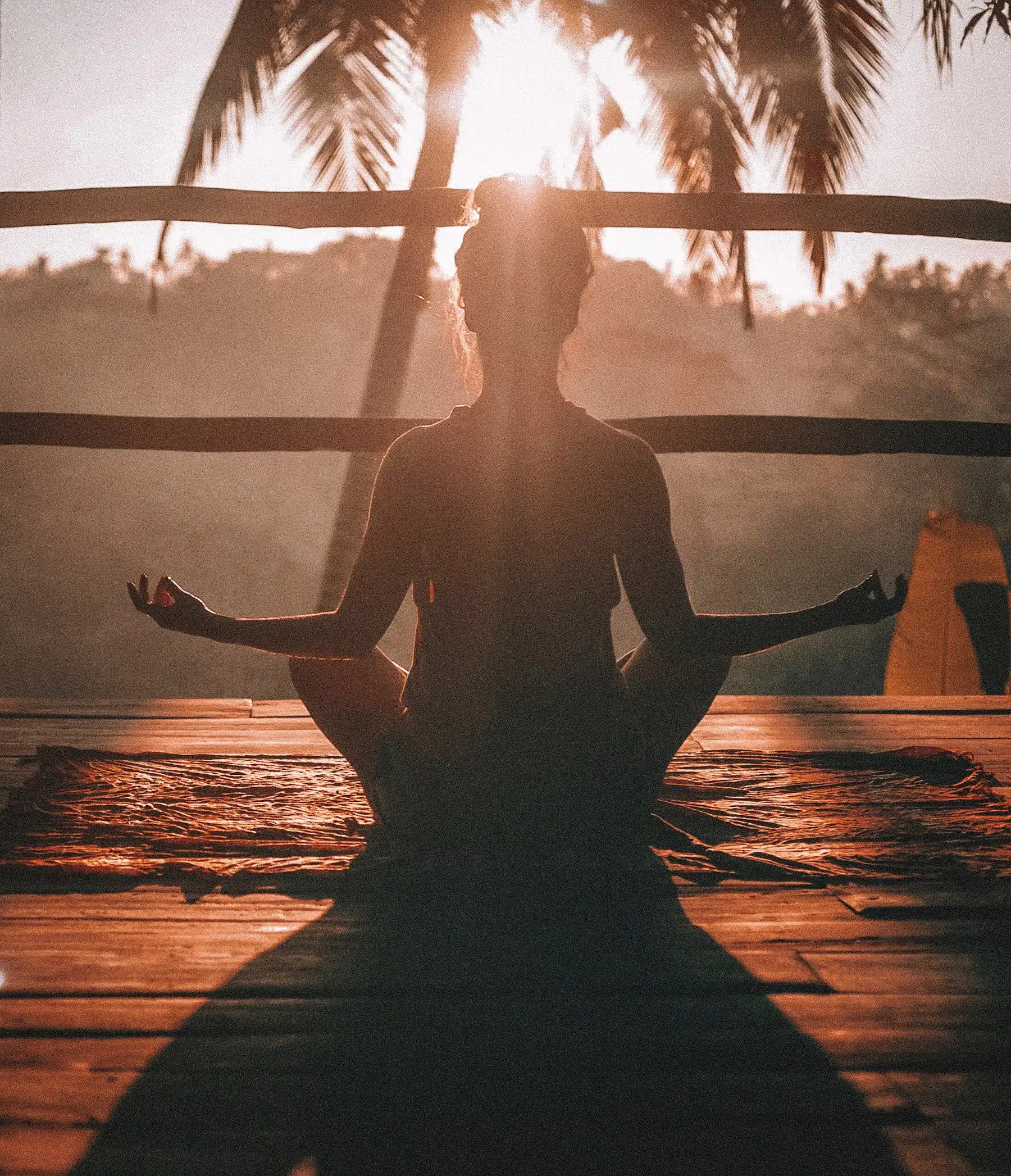How to Plan a Meditation Routine When You Have a Busy Schedule
Meditation has been proven through research to have a whole host of benefits for our wellbeing and happiness. Most people who have tried it would like to practice it consistently. The key to experiencing the benefits of a meditation practice is to have a consistent meditation routine that we keep every day, irrespective of the curve balls life throws our way.
Making meditation part of your daily routine may require a bit of a mindset shift and some planning, but the benefits are well worth it. Vedic Meditation is a twice-per-day program, so in this post, we’ll cover the steps each student learns to integrate 2 meditations into their schedule.

The Morning Meditation Routine
Morning meditations are the easiest to integrate into our schedule. Making time in the morning for self-care lets us start our day slowly and calmly, with space for ourselves before the demands of the day start. The best way to add meditation to your morning routine is to go to bed 30 minutes earlier and wake up 30 minutes earlier.
It may take a few days of adjustment to an earlier sleep and rising schedule, but once you’ve built a refreshing morning routine, you won’t want to go back.
When you wake up, it’s tempting to stay warm in bed and ‘meditate’ right where you are under the covers- but that is a sure way to fall back asleep and miss the benefits of a morning meditation session. Falling asleep inside meditation isn’t an issue, but we don’t want to set ourselves up for sleep.
Wake Up Fully
To start your daily meditation routine, get out of bed when you wake up, splash some water on your face and wash up. Make sure there’s some gap time between your sleep state and your waking state before you sit for your meditation.

Start your Meditation Journey Today
ATTEND A FREE INTRO TALKWait for Caffeine
As much as you may crave your morning coffee or caffeinated tea, avoid eating food or taking in caffeine or stimulants before you meditate in the morning. Caffeine will prevent your body’s ability to relax into meditation, and keep your nervous system from downregulating into a state of deep rest. It’s best to wait to have caffeine and stimulants until after your meditation for the best results.
Keep Your Phone on Silent
Another tip is to keep your phone on airplane mode or off until after your meditation is complete. This way you won’t feel as tempted to check messages, notifications, and email until after your meditation is complete. You’ll also protect your slowly-waking brain by avoiding notifications– it’s the difference between setting your mind directly after seeing a flurry of activity from your phone and settling into meditation easily after an evening’s sleep, without the distractions of overnight messages and notifications.

An Afternoon Meditation Routine
The second session in your meditation daily routine is usually the one that my students and clients report are more challenging to consistently make time for every day. It is equally important as our morning meditation, since two meditations per day allow us to release stress more quickly than our body can accumulate it.
Schedule It In
The first step is to schedule it into your calendar every day, like a meeting with yourself for twenty minutes. When you take time to schedule regular meditations so they appear in your diary, calendar, or planner, you’ve carved out time mentally and into your day that will be harder to skip or schedule over.
It’s not important to schedule your meditations at the same time everyday. Our lives are dynamic and we want to honor that dynamism and be adaptable. The most important thing is to get your meditations in every day, so be tactical about when the meditations are going to happen and preplan to the best of your ability.
I suggest for all new meditators who come through my course that they plan out their second meditation of the day, even on the weekends, for the next six weeks.
Get Creative About Where You Meditate
The second tip for how to do daily meditation in the afternoon as well as in the morning is to get creative about where you meditate. You don’t need a special sanctuary for Vedic Meditation or even a special seat or pillow.
Vedic Meditation is a portable practice that we can do anywhere. You can meditate on a plane or in a hotel lobby, in your car, or in your office. Anywhere you feel safe that is reasonably non-disruptive.
It’s okay to have background noise around you, it doesn’t have to be perfectly silent. If you have a house full of guests or you’re with lots of people over the holidays, you can even find a quiet closet to meditate for twenty minutes.
This is one of the benefits of Vedic Meditation, is that it’s very portable and inclusive to life. Thoughts are okay in Vedic Meditation, and if we’re stimulated for a moment we can just return to our mantra afterwards.
Make Meditation Non-Negotiable
When you’re wondering how to create a meditation routine, the thing that will make the biggest difference is to decide that both meditations are non-negotiable every day. When we making our twice-daily practice non-negotiable, we are committing to systematically relaxing the body and reaping all the benefits of from that commitment – less stress, more adaptability, increased resiliency, and greater baseline happiness.
You have to become a bit of a meditation maniac to fit the second meditation in every single day. It takes some discipline. You have to be willing to sneak off and let people know you’ll be unavailable for the next twenty minutes.
You have to require an afternoon or evening break even when it’s not otherwise in the schedule. You have to be willing to stop what you’re doing and let life go on for twenty minutes while you release stress and come in contact with pure silent inner state.
Whenever we step away to meditate, we’ll feel more empathetic, resourceful, patient, and refreshed afterward. We’ll be a better version of ourselves when we step away to meditate every afternoon.
So whenever you’re thinking about skipping out on meditation because you don’t want to be a bad friend or you don’t want to be late for something, always remember that you will show up to that place as a shinier, more refreshed version of you and everybody gets to benefit from that.
Make an Evening Meditation Routine
When you’re considering how to start a meditation routine, it makes a difference to make a good evening routine that sets you up for the next day and morning. The more you meditate, the more you’ll have an accurate sense of what you can accomplish each day, and the more you’ll be able to complete your tasks and attend to daily demands without pushing yourself beyond your limits, staying up too late, or giving up personal rest time.

Find a Practice You Like
When you find a meditation practice you enjoy, you’ll want to do it every day. If it’s something that leaves you feeling frustrated or like you’re making little progress, you’ll find every reason to miss meditations.
But when your meditation is a place for you to unwind and wash the stresses of the day away,, and you feel consistently refreshed after every sitting, your meditations will be something you look forward to.
Most people who practice Vedic Meditation report that it’s one of the most enjoyable things they do in their day to rest, relax, and recharge.
The longer you meditate, the more you’ll notice the benefits over time. You’ll feel more resilient to stress and more open and generous with other people, and things that used to trigger you won’t be able to upset you as easily.
When you do feel triggered, you’ll be able to calm back to homeostasis and make good decisions more quickly and easily. You may even notice that certain habits or behaviors drop away entirely, even though you can’t put a finger on when or why they stopped.
Within a six weeks of practicing Vedic Meditation, making time for meditation will feel as natural as making time to have breakfast, to drink water, or to go to sleep at night.
Build Accountability
One of the ways to stick to your meditation practice is to get involved with other meditators or request accountability from someone you trust. I host a weekly group meditation and knowledge session with my students, which is a great way to share your breakthroughs and growth from the week, and to hear even more tips from other meditators about how they stay consistent with meditation.
When you hear other meditators sharing the benefits they are noticing from their practice, you can be inspired by the ‘benefits to come’ from your own practice. And when you’re learning Vedic knowledge every week through group meditation or through reading the newsletters and podcasts of Vedic teachers, you’ll continually remember why it’s important to release stress through meditation twice each day.
Learn to Meditate
To receive your own Vedic Meditation mantra and start a twice daily practice, schedule an intro talk with me, or sign up for my next Learn to Meditate Course. We’ll integrate a morning and afternoon meditation into your day as a part of the course, and you’ll have accountability with me and the Vedic Meditation community.






